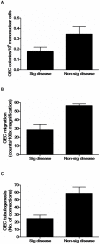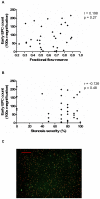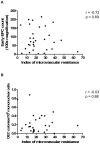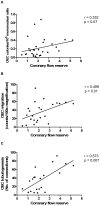The relationship between endothelial progenitor cell populations and epicardial and microvascular coronary disease-a cellular, angiographic and physiologic study
- PMID: 24736282
- PMCID: PMC3988011
- DOI: 10.1371/journal.pone.0093980
The relationship between endothelial progenitor cell populations and epicardial and microvascular coronary disease-a cellular, angiographic and physiologic study
Abstract
Background: Endothelial progenitor cells (EPCs) are implicated in protection against vascular disease. However, studies using angiography alone have reported conflicting results when relating EPCs to epicardial coronary artery disease (CAD) severity. Moreover, the relationship between different EPC types and the coronary microcirculation is unknown. We therefore investigated the relationship between EPC populations and coronary epicardial and microvascular disease.
Methods: Thirty-three patients with a spectrum of isolated left anterior descending artery disease were studied. The coronary epicardial and microcirculation were physiologically interrogated by measurement of fractional flow reserve (FFR), index of microvascular resistance (IMR) and coronary flow reserve (CFR). Two distinct EPC populations (early EPC and late outgrowth endothelial cells [OECs]) were isolated from these patients and studied ex vivo.
Results: There was a significant inverse relationship between circulating OEC levels and epicardial CAD severity, as assessed by FFR and angiography (r=0.371, p=0.04; r=-0.358, p=0.04; respectively). More severe epicardial CAD was associated with impaired OEC migration and tubulogenesis (r=0.59, p=0.005; r=0.589, p=0.004; respectively). Patients with significant epicardial CAD (FFR<0.75) had lower OEC levels and function compared to those without hemodynamically significant stenoses (p<0.05). In contrast, no such relationship was seen for early EPC number and function, nor was there a relationship between IMR and EPCs. There was a significant relationship between CFR and OEC function.
Conclusions: EPC populations differ in regards to their associations with CAD severity. The number and function of OECs, but not early EPCs, correlated significantly with epicardial CAD severity. There was no relationship between EPCs and severity of coronary microvascular disease.
Conflict of interest statement
Figures







References
-
- Asahara T, Murohara T, Sullivan A, Silver M, van der Zee R, et al. (1997) Isolation of putative progenitor endothelial cells for angiogenesis. Science 275: 964–967. - PubMed
-
- Rauscher F, Goldschmidt-Clermont P, Davis B, Wang T, Gregg D, et al. (2003) Aging, progenitor cell exhaustion, and atherosclerosis. Circulation 108: 457–463. - PubMed
-
- Güven H, Shepherd R, Bach R, Capoccia B, Link D (2006) The number of endothelial progenitor cell colonies in the blood is increased in patients with angiographically significant coronary artery disease. J Am Coll Cardiol 48: 1579–1587. - PubMed
-
- Kunz G, Liang G, Cuculi F, Gregg D, Vata K, et al. (2006) Circulating endothelial progenitor cells predict coronary artery disease severity. Am Heart J 152: 190–195. - PubMed
-
- Shantsila E, Watson T, Lip G (2007) Endothelial progenitor cells in cardiovascular disorders. J Am Coll Cardiol 49: 741–752. - PubMed
Publication types
MeSH terms
LinkOut - more resources
Full Text Sources
Other Literature Sources
Miscellaneous

